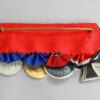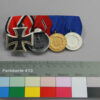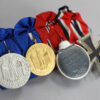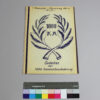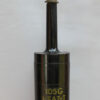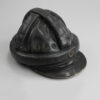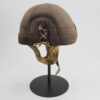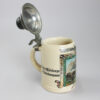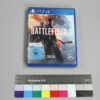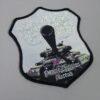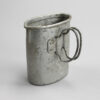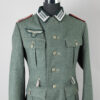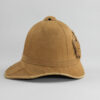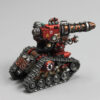Large medal clasp (worn by the German Armed Forces)
Inventory number: DPM 3.2449.1-5
The medal clasp bears the Iron Cross Second Class, the Winter Battle in the East medal and two Wehrmacht service awards for 4 and 12 years respectively. However, it does not date from the National Socialist era, but was worn by a Bundeswehr soldier.
In 1945, the Allies banned the wearing of military decorations, but this ban was lifted when the Federal Republic of Germany was founded in 1949. Nevertheless, it took a few more years before the law on “Titles, Orders and Decorations” was passed in 1957. This allowed awards from before 1933 to be worn without restriction and a selection from 1934 to 1945. From then on, the orders and decorations from the National Socialist era could only be worn in a modified version: As a version without National Socialist emblems – most notably the swastika. This regulation also applied to all war decorations permitted again by the law. Some decorations remained banned under the 1957 law, such as the Bandenkampfabzeichen.
The former bearer of this medal clasp belonged to the 7th Panzer Division of the Wehrmacht. When the Bundeswehr was formed in 1955, many other former Wehrmacht soldiers donned the uniform of the citizen along with him. There were hardly any tests of character for those who re-enlisted. Just as the Bundeswehr was unable to form itself without the former Wehrmacht soldiers in its early years, the new armed force was unable to completely leave the traditions of the Wehrmacht behind with the old soldiers.
The largely unpopular new army was unable to recruit enough new soldiers during the economic boom, and the Allies also encouraged the appointment of soldiers with combat experience against the Soviet Union to senior posts, which was seen as an advantage in the growing East-West conflict. To motivate these men, it was only logical that they were also allowed to wear their decorations: The Winter Battle in the East medal was only awarded to those who took part in the war against the Soviet Union in the winter of 1941/42, which is why it was also known as the “Frozen Meat Medal”.
Object of the month
(short) stories from the depot
Unfortunately, many objects cannot currently be shown in the exhibition for conservation reasons. Here you will find unusual objects and exciting stories of special pieces from the depot


